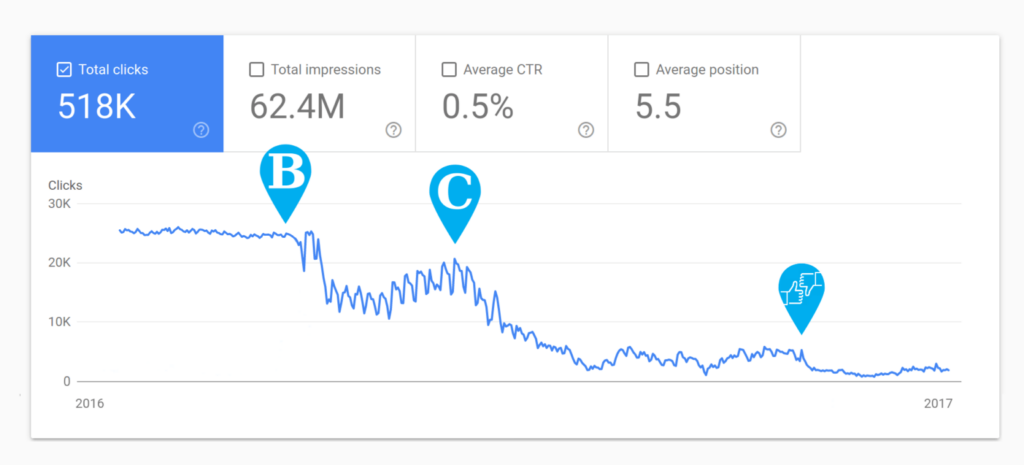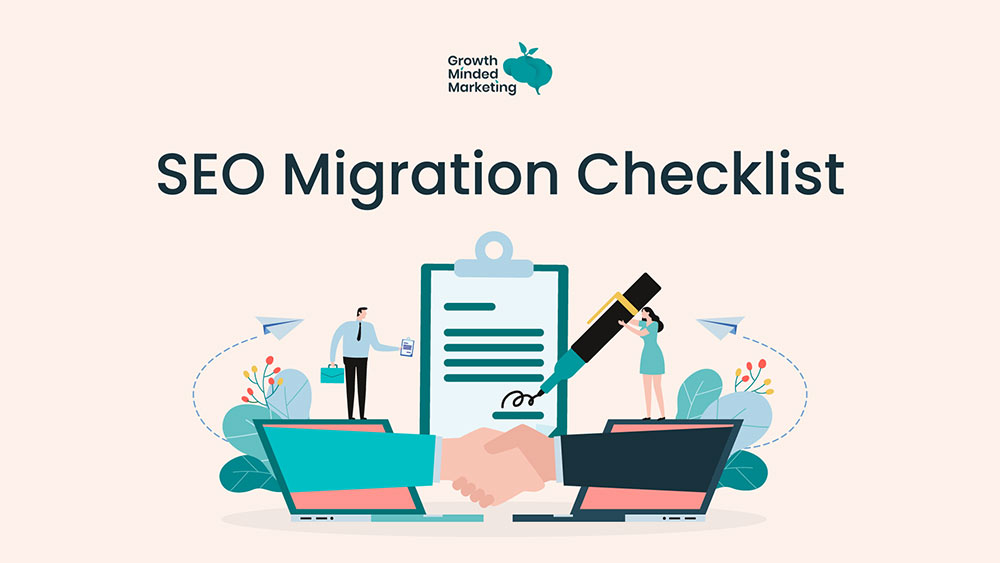You must have heard SEO migration horror stories where people drastically lose search rankings with parts of the website taking months (or even years) to fully recover.
Site migrations are indeed risky, but the benefits usually outweigh the risks – and in most cases, a website migration becomes more of a need than just a fancy exercise companies embark in order to spend allocated budgets for the year.
If you are planning to migrate your website, this article can save you from making common migration mistakes by providing you with an easy to follow migration checklist which should allow you to not lose anything* in the process.
*Traffic/rankings/your sanity/your job 😆
Table of Contents
ToggleWhat is a Website Migration?
Website migration is the process of relocating a website from one domain, hosting environment, or content management system to another.
This is done to achieve various objectives, such as updating technology, redesigning the website, or rebranding, while ensuring minimal disruption to the site’s search engine rankings and user experience.
The major implications a migration can have on SEO performance and search engine rankings is the reason why migrations are often known as SEO migration.
For example, migrating your website from http to https requires major restructuring where you send all the traffic to new HTTPS pages with a redirect.
Migrations like these are technical and risky – it’s a complicated process.
You’ll lose rankings when the migration process begins and if not done right, it could be very difficult to bounce back. The process requires planning, proper execution, and monitoring to ensure everything is performing as expected.
Why do a site migration?
Despite these risks, why do businesses and website owners embark on site migrations?
Here are the major reasons to migrate a website:
- Changes in technology: When you want to make a switch to better technology which includes changing your CMS, updating on-premise hardware and servers, integrating platforms such as Shopify and WordPress.
- Site location: This is the most common type of site migration where you have to change the location of your site from one domain to another, merge two websites, redirect a website, geo redirects, rebranding, etc.
- Redesigning: Minor design tweaks do not necessarily need a migration, but major redesigns where you change design end-to-end usually require migration. For example, creating a separate website for mobile or creating different websites for different types of visitors based on their location.
- Restructuring: It involves website structure and hierarchy-related changes such as navigation tweaks, moving internal pages and posts, changing URL structure, etc.
- Content changes: A rapidly growing website migration type where you have to update, merge, or remove content.
- Hosting company switch: When you have to change your hosting company, you have to migrate your website to the new host.
5 Most Common Migration Pitfalls
If you are planning to do a site migration, you should avoid the following pitfalls:
1. Poor planning
Site migration is a complex task and it requires proper planning and documentation. Lack of planning or poor planning is a major mistake most businesses make during SEO migration of their websites.
There are a lot of key factors to consider before, during, and after site migration. This includes:
- The purpose of site migration
- Resource allocation
- Team structuring and hierarchy for streamlined and centralised communication and reporting
- Turnaround time preferably through a Gantt chart to manage other related tasks
- Complete the migration procedure and steps
- Alternate plan of action if something goes wrong during or after website migration.
Not planning for these factors could cause irreparable damage to the migration process.
2. No SEO considerations
Website migration and SEO go hand in hand. There are multiple ways migration impacts SEO including:
- Redirects
- Site downtime
- Crawl and index issues
- Loss of rankings
- Reduction in organic traffic.
Improper site migration could lead to one or more SEO issues and it’s a very common migration pitfall.
3. Internal team communication failure
Businesses that have multiple teams or individuals face a severe challenge that could lead to multiple issues during site migration if they all are not onboard.
For example, the marketing team misses exporting all the content from the CMS when you are moving to a new hosting company. This means your marketing team now has to upload and publish all the content manually again with the new host.
Not only is this a tedious task but it will lead to numerous SEO issues in the long run.
4. Lack of testing
There are certain types of migration where you need to test the new environment before making the transition. And this is something that a lot of brands miss or don’t have the knowledge or resources to do so.
For example, if you are making major design or content changes to your website, you can leverage website staging (a private environment where you can see and test website changes before publishing them live).
Making untested changes to your live website must be avoided at all costs.
5. Deadlines are too short
Site migration is a time-consuming process. Rushing through the process or setting too short deadlines is a common mistake top management makes. This is because they are more concerned about getting things up and running as quickly as possible with minimal downtime.
Website Migration Examples
Here are a couple of website migration examples to help you stay prepared and informed:
Unsuccessful site migration examples
Here is an example where traffic dropped significantly when a jewellery retailer website was migrated to a new domain (B) and then later to another domain (C) with a poor backlink profile:
Here is another example of how SEO migration impacts search visibility in Bing when it is not done right:
This site created incorrect redirects which led to a significant decline in traffic:
You don’t just have to do it – you have to do it correctly. Redirects during migration (which are necessary) have to be implemented using the right methodology.
Successful site migration examples
When website migration is done correctly with proper planing and inspection, it has the potential to significantly improve SERP performance across various search engines:
Here is another example of a website that created separate pages for different locations which led to an instant traffic spike:
SEO Migration Checklist: How to Do a Migration?
Site migration is a risky process, but it has a lot of potential when done right. It helps you achieve your primary goal and improve rankings and organic traffic.
The best and easiest way to run SEO migration successfully is by following a migration checklist.
An SEO migration checklist is a list of all the steps and actions you have to take so that you don’t miss any critical steps. Since it is a long, multi-day process that involves multiple teams, individuals, and technologies, it is highly likely to miss a step.
The checklist simplifies the migration process and it makes it easy to keep everyone onboard. Your team knows what tasks they have to perform, when they have to do it, and once a task in the checklist is completed, you know it is done – and you can move to the next item in the list.
Here are pre and post migration checklists that we think could help you with the process:
Pre-migration checklist
The pre-migration checklist includes tasks that must be performed before the migration process:
1. Running a crawl on the current site
Crawling your existing website helps you understand website structure and download a copy of it so you can use it post-migration for comparison or import. A typical crawler provides you with results related to on-page SEO, indexing, site health, and URL structure.
You will know how many pages you have indexed, internal link structure, canonical, errors and warnings, and other key information from a crawl, and this helps you ensure you have a similar structure post-migration.
Screaming Frog is a popular website crawl tool that gives you a report like this:
It is quite detailed and helps you maintain a record of your current site.
2. Downloading reports to secure pre-migration data
Here are the major reports you should download from the crawler for future use:
- List of current indexed URLs with a complete URL list
- Current traffic statistics. You can use Google Analytics or the analytics tool you are using to download traffic report
- Detailed backlink report
- XML sitemap of your website
- All the content including posts, pages, tags, categories, media, and others.
3. Downloading pre-migration keyword rankings
Keyword ranking report is helpful for comparison and to identify migration issues so they can be addressed on time.
There are multiple ways to download keyword rankings of your current website:
- Use a keyword rank tracking tool like Ahrefs or Semrush
- Use Google Search Console and Google Analytics to download keyword ranking and traffic estimation reports.
4. Creating a redirect map
This is a critical pre-migration step.
A redirect map is the process of identifying new pages where existing pages from the current website will be redirected. You don’t have to create redirects at this stage, but you need to create a map which looks like this :
You can create a redirect map in Excel based on the crawl report. List all the indexed pages on the current website and have a new URL for each one. The purpose of a redirect map is to ensure that no old URL is missed from redirection. It has to be a 1-1 redirect.
5. Technical audit on the staging site
Is your staging site technically sound and ready to be deployed?
Running a technical audit helps you determine if it is technically sound and ready. It involves running a complete technical audit that isn’t just limited to SEO.
Some of the major technical checks include:
-
- Site structure and navigation analysis
- SEO audit
- Crawl report
- Design and UX analysis
- Site speed performance
- Sitemap analysis

Google Ads tips
Learn advanced tips that PPC professionals use to dramatically increase their Google Ads performance!
Post-migration checklist
Once you have migrated your website and the staging site goes live, you have to go through the following post-migration checklist to ensure everything is working as expected:
1. Crawl the old site
Yes, you already did but that was pre-migration with no redirects.
Running a crawl post-migration on the old site shows you URLs where they are redirected to. Screaming Frog has a built-in feature to monitor redirects. Here is an example :
You can monitor the complete redirect chain and current statuses.
Ideally, all the URLs from the old site must redirect to the corresponding URLs on the new site after migration. Refer to the redirect map to cross-check redirection.
2. Crawl the new site
Run a crawl on the new site to ensure all the URLs are live without any errors.
It is normal to have errors such as canonicals, missing meta descriptions, redirect hops, blocked URLs, and other warnings. A crawl helps you identify all these errors.
The major issues you need to look for include:
-
- Missing or uncrawlable URLs
- Blocked URLs
- Redirect hops
- Number of live URLs (and this should match the redirect map)
- Site structure
- Missing tags
You can use any tool to crawl your website including Ahrefs, Semrush, Screaming Frog, etc.
3. Sitemap and robots.txt
Analyse the sitemap and robots.txt file of the new site before making any tweaks.
The XML sitemap must be formatted properly so that search engines can read it. Use this free XML sitemap validator to inspect your new site’s sitemap.
You can use a robots.txt tester to identify issues and warnings. Here is a free robots.txt tester that does a decent job of identifying errors.
Google has a robots.txt tester to find errors and warnings in your file. However, it only works for verified properties via Search Console (see below for details).
4. Google search console and GA4
Setting up your new site with Google Analytics and Search Console is one way to identify bugs and errors. This is, however, only applicable when you have changed the domain name.
If you have migrated within the same domain name, you don’t have to add your property again, rather submit a new sitemap to Search Console.
Optionally, you can use the built-in features of the Search Console to run a few quick tests:
- Submit URL for indexing manually
- Use PageSpeed Insights to identify speed and UX issues on the new site
- Fix and validate errors identified and reported by the Search Console
If you have switched domains, you should set up your new property in Search Console and GA4 and connect them. Verify your property, submit a sitemap, and wait for Google crawlers to crawl your new site.
One of the biggest advantages of using Search Console is that you get error messages from Google and you can fix them right from your Console dashboard.
Google doesn’t crawl your new website quickly and would need weeks or even months in some cases to fully crawl all the URLs. The good thing is that you don’t have to use any third-party crawler in this case.
5. Backlink update requests
Backlinks are the backbone of SEO and are among one of the most important ranking factors . They are hard to acquire, especially high-quality ones.
While 301 redirects pass the link equity and once you have migrated your site successfully with proper redirects, your backlinks will point to new URLs automatically (and the link equity will still pass on).
From a UX perspective, it doesn’t look nice. And when you have hundreds of redirects, it seems a bit too much from a search engine crawler’s perspective.
It is best to reach out to webmasters and request them to update the URLs for the backlinks. This is a quick way to index new URLs as web crawlers can quickly find new URLs via backlinks.
Sending requests is a great way to make your new URLs visible and indexable.

Google Ads tips
Learn advanced tips that PPC professionals use to dramatically increase their Google Ads performance!
Conclusion
Successful website migration is definitely a technical process! It is not impossible to do SEO migration of your site yourself, a lot of businesses do it in-house. You need to stick with the pre and post migration checklist and avoid major pitfalls to ensure you don’t end up doing more harm than good to your site.
However, the probability of making mistakes is quite high.
One tiny wrong move and it can take months to recover.
This is where we can help you. Leave site migration and technicalities to us while you can focus on your business. Reach out to Growth Minded Marketing for help with site migration and technical SEO services.

Find out how our SEO management services can help your business grow in 2024













